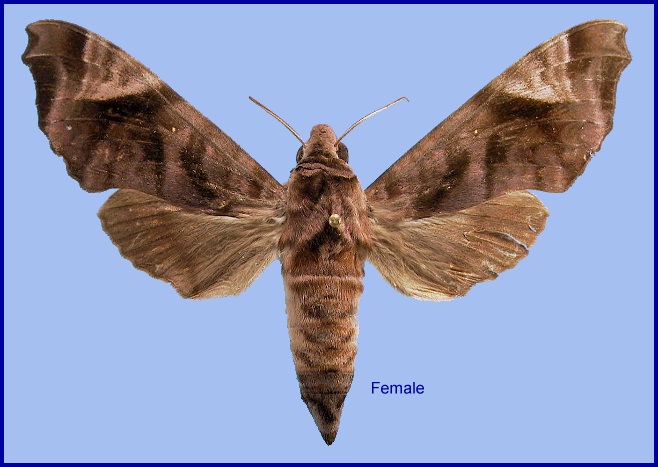
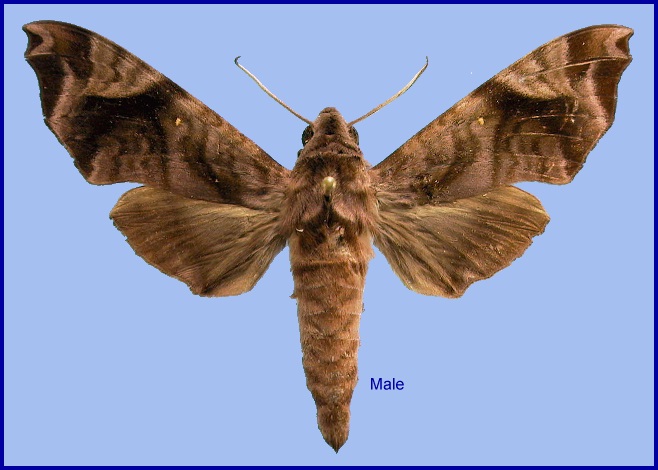
Acosmeryx anceus subdentata Rothschild & Jordan, 1903, Novit. zool. 9 (suppl.): 528. Type locality: [India,] Sikhim [Sikkim]; [India, Meghalaya,] Cherrapunji; [India, Meghalaya,] Khasia Hills [Khasi Hills]; Bhutan; [Indonesia,] Sumatra [Sumatera]; [Indonesia,] Java [Jawa].
Wingspan: 70--88mm. The smallest species of the genus, and markings different from those of all the other species. Forewing distinctly angulate at vein M3, often with traces of teeth. Upperside: tawny-cinnamon to chestnut-brown; an oblique distal band diffuse posteriorly; first discal line heavy, continuous; greyish costal apical area stopping at M1 or beyond it; a broad, curved, pinkish-grey submarginal line continuous with apical lunules of the same colour. Hindwing fuscous. Underside: forewing ochraceous clay-colour; a subapical, triangular, costal, chestnut patch extending to M1, straight proximally, where it is bordered by a grey or pinkish-grey line or patch; outer disc between M1 and 2A+3A pinkish-vinaceous or vinaceous-cinnamon, not so dark as the subapical patch; pinkish-grey submarginal scaling extended basad, basal half of costal margin of the same colour as the hindwing. Hindwing vinaceous, brown marginal border reaching M2 only half-way to second pair of discal fines. Palpus, breast and first two abdominal sternites pinkish (Bell & Scott, 1937).
In the male genitalia, harpe much more prolonged than in the other species. Phallus with a broad left process rounded at end and dentate at distal and proximal edges.
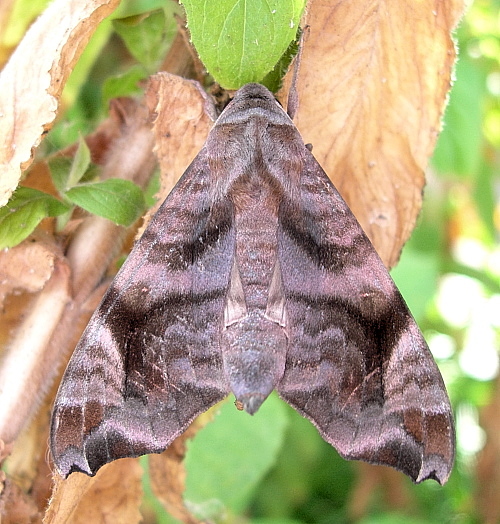
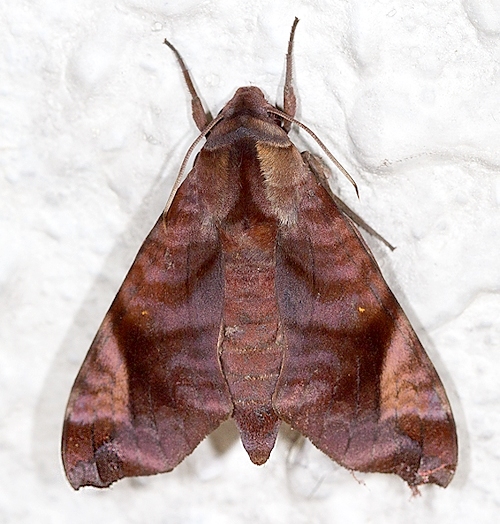
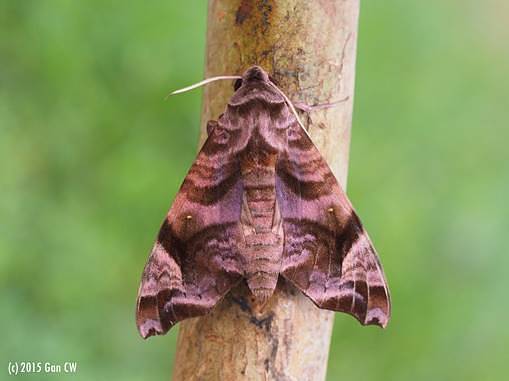
In southern India, a species of dense forests with heavy rainfall, from sea-level to about 2000' altitude (Bell & Scott, 1937). This is the same for Yunnan, China (Pittaway, pers. obs.)
China: 28.iii-11.vi (Hong Kong); v (Yunnan); vi (Jiangxi; Guangxi; Yunnan); 8.viii (Yunnan); 8.viii-29.x (Hong Kong).
OVUM: Not documented.
LARVA: Full-fed 90--95mm long, 10mm wide. According to Bell & Scott (1937), in the final instar head round, body of the same shape as others of the genus. Horn down-curved, cylindrical to near tip, then narrowing abruptly to a short point; shiny, covered with small, flattened, pear-shaped tubercles. Head glaucous-green, tubercles white. Body green with short dark green longitudinal stripes above the flange. The dorso-lateral stripe, which extends from segment 2 to the base of the horn, is narrow and yellow on segment 2 to 5, broad and white on 6 to 12, and edged narrowly above by plum-colour, more broadly below by pink on 6 to 12. The flange is edged broadly with yellow on segments 2 and 3, and the anterior half of 4, but with brownish-maroon on the rest of 4 and 5. There are yellowish-green oblique lateral stripes on 6 to 11. Horn reddish-brown; true legs dark reddish-brown; anal flap edged with yellow. Spiracles white, the slit black and edged on each side with black, the whole with a shiny black rim (Bell & Scott, 1937). [A plate from Butler (1876)].
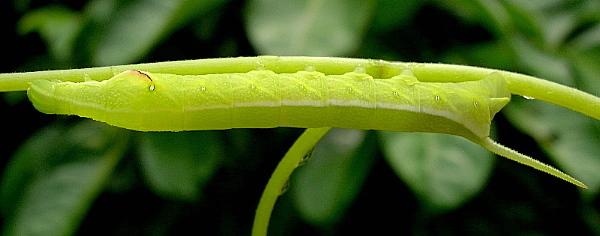
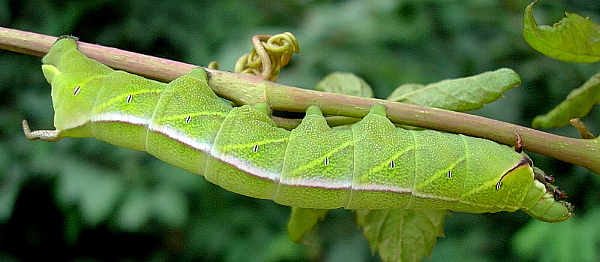
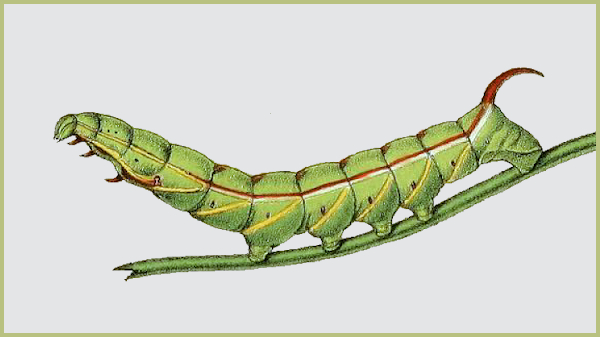
PUPA: 48mm.
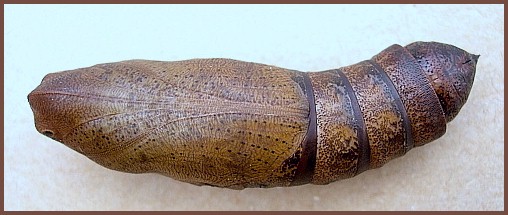
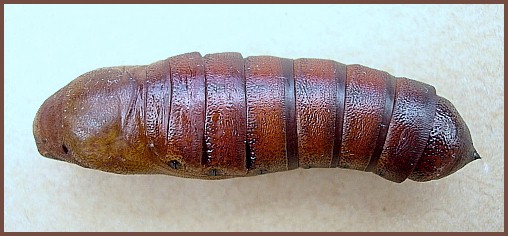
Larval hostplants. Leea, Cayratia, Cissus and Vitis (Inoue, Kennett & Kitching, [1996] 1997). On Taiwan, on Ampelopsis brevipedunculata.
China: Chongqing (Tuokou; Chongqing); Yunnan (Changning Co., Songzhishanding, 2800m; Xishuangbanna Co., Yexianggu; Simao/Pu'er); Jiangxi (Le'an); Guangxi (Guigang; Guiping Station, Longtan National Forest Park); Hong Kong (Tai Po; Lam Tsuen Valley; Kam Tin Valley; Sai Kung (Sterling & Kendrick, 2011)); Hainan (Duowen Ling, nr Lingao).
Taiwan: Lu Tao; Orchid Island/Botel Tobago.
Southern and eastern India (Assam, Goa, Himachal Pradesh, Karnataka, Sikkim, West Bengal (Kaleka, Kaur & Singh, 2020)), Nepal, Bhutan (Irungbam & Irungbam, 2019), Burma/Myanmar, Thailand, southwestern China (Yunnan, Guangxi, Hong Kong), Vietnam (Le & Vu, 2024), Malaysia (Peninsular, Sarawak), Indonesia (Sumatra, Java, Kalimantan, Sumbawa), the Philippines (Inoue, 1996).
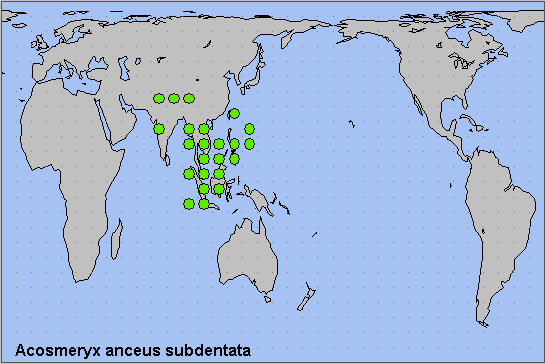
 Return to Sphingidae of the Eastern Palaearctic species list
Return to Sphingidae of the Eastern Palaearctic species list